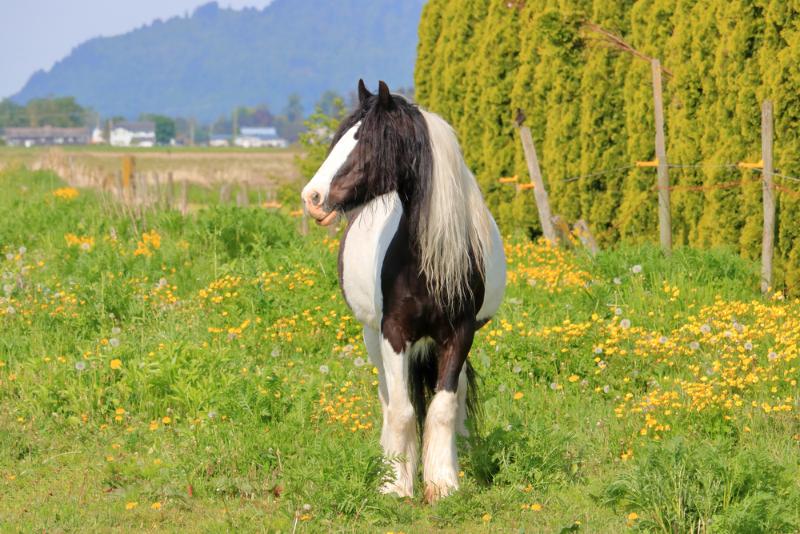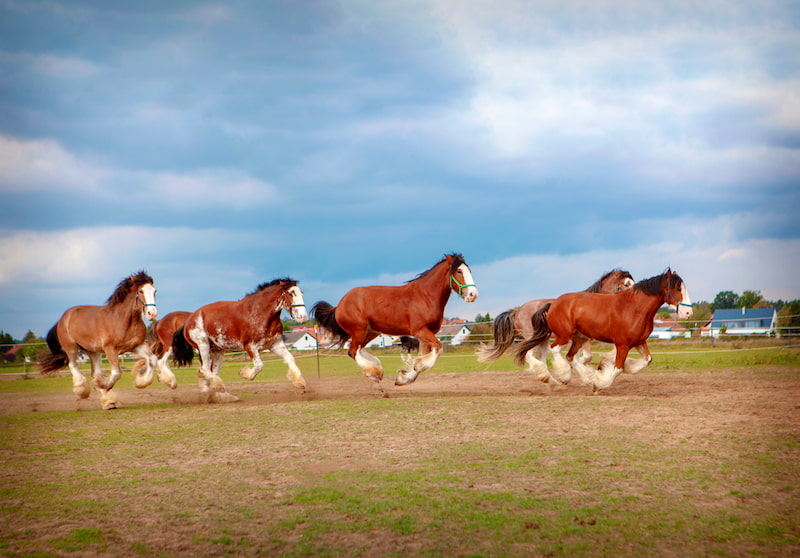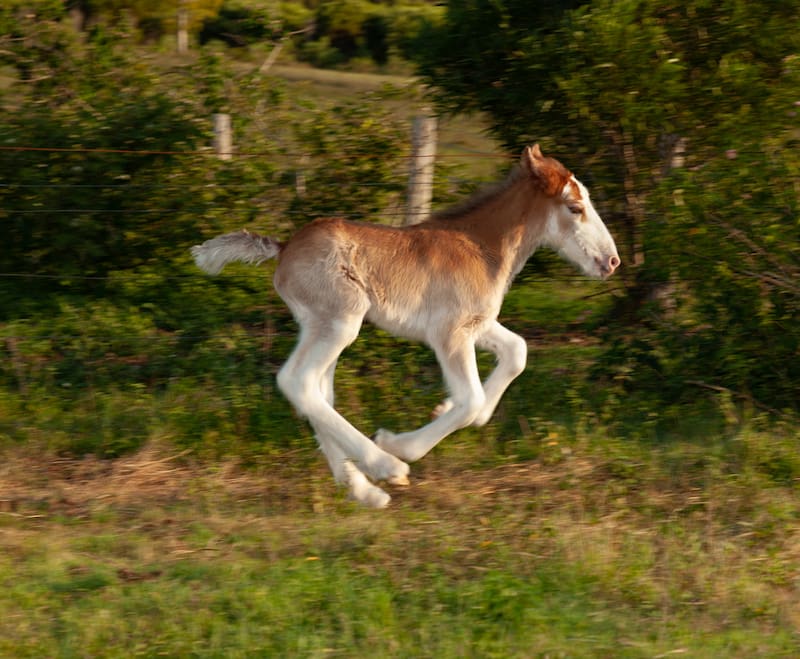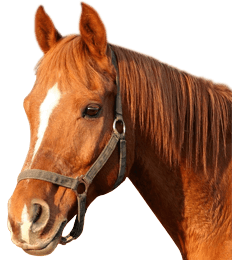The Clydesdale Horse: Australia's Magnificent Heritage Breed
The Clydesdale horse, with its impressive stature, flowing feathered legs, and gentle temperament, has earned a special place in Australian history. So significant was their contribution to the nation's development that they became known as "the breed that built Australia." This comprehensive resource explores the rich history, distinctive characteristics, and contemporary relevance of these magnificent horses in the Australian context, drawing on historic records and modern practices to provide a complete understanding of this beloved breed.
The Rich Heritage of Clydesdales

Scottish Origins and Development
The Clydesdale horse originated in Scotland, specifically in the Lanarkshire region (formerly called Clydesdale) centered around the River Clyde. The breed's development began in the 17th century when Flemish stallions were imported to Scotland and bred with local mares. By the 18th century, these horses were recognized as a distinct breed, with formal breeding criteria established by 1815.
The first official use of the name "Clydesdale" for the breed occurred in 1826, and the Clydesdale Horse Society of Great Britain and Ireland was founded in 1877, publishing its first stud book the following year. During the 19th century, Shire blood was introduced to the breeding program, increasing the horses' height and bulk.
Journey to Australia
The first recorded Clydesdale arrival in Australia was in 1824 when the Australian Company imported a "beautiful entire Clydesdale horse" on the ship Triton. While draught horses existed in Tasmania earlier, it was during the Gold Rush of the 1850s that Clydesdales were imported in significant numbers directly from Scotland to New South Wales and Victoria.
Victoria quickly established itself as the principal supplier of heavy horses to other parts of Australia. The Clydesdale's popularity in Australia grew rapidly because the breed possessed the strength, longevity, and quick, long stride required for developing roads, operating farm machinery, and supporting the Victorian gold rush.
Formation of the Australian Clydesdale Society
In 1904, a committee was formed to publish a "Draught Horse Stud Book for Victoria," which initially included Clydesdales, English Shires, and Suffolk Punches without distinction. By 1911, the breeds were classified into separate sections, with horses showing two crosses of traceable Clydesdale blood on the sire's side and one on the dam's side classified as Clydesdales.
In 1917, a rival group of breeders in New South Wales established "The Australia Clydesdale Stud Book," creating a split between the states. This division was finally resolved in 1923. The Commonwealth Clydesdale Horse Society (CCHS) was founded in 1918 through the merger of existing heavy horse organizations. Since its inception, the CCHS has registered 8,720 members, 4,400 Clydesdale studs, and almost 30,000 registered Clydesdales.
Physical Characteristics and Breed Standards

Appearance and Conform ation
The Clydesdale is a large, powerful draught horse with a distinctive appearance that sets it apart from other heavy breeds. These horses typically stand between 16-18 hands (1.63-1.83 meters) tall and weigh between 800-998 kilograms (1,800-2,200 pounds).
A well-proportioned Clydesdale should be evenly balanced, with the depth through the chest approximately equal to the length of leg. The body should appear broad and thick when viewed from the front or rear. The head should be in proportion to the body, with a straight or slightly Roman-nosed face, thin rather than heavy lips, and reasonably large, oval eyes.
The chest should be deep, wide, low, and of large girth, indicating a strong constitution with ample space for vital organs. The back should be short, broad, strongly supported, and slightly inclined upwards towards the croup. The hind quarters, as the primary source of driving power, should be well-muscled with a long, sloping croup.
Distinctive Features and Coloration
Clydesdales are immediately recognizable by several distinctive features. Their lower legs are adorned with abundant feathering – long, silky hair that flows from the back of the cannon bone. This feathering serves a practical purpose, acting as an efficient drainage system to channel water away from the delicate heel area, which is susceptible to skin conditions.
Most Clydesdales are bay, brown, or black, though chestnut is also seen. They typically feature bold white markings on the face (often a blaze), legs, and sometimes the underbelly. Many exhibit roaning or sabino-like flecks of white throughout their coats. Their hooves often display distinctive black and white striping.
Temperament and Behavior
Clydesdales are renowned for their gentle, calm, and easygoing temperament, making them excellent working partners despite their imposing size. They are intelligent and alert, with a willingness to please that facilitates training for various disciplines.
This combination of power and docility has contributed significantly to the breed's historical value as working animals and their modern versatility in various roles. Their amenable nature makes them suitable for handlers with different experience levels, though their size always demands respect and proper training.
Care and Management in Australian Conditions

Nutritional Requirements
Despite their size, Clydesdales are generally "good doers," meaning they maintain condition easily on a basic diet. As a general rule, they consume approximately 2% of their body weight daily. For an average Clydesdale weighing around 800kg, this translates to roughly 16kg of feed per day.
Nutritional requirements vary based on work level, age, and reproductive status, with broodmares and growing horses having specific needs. In the Australian climate, access to clean water and appropriate electrolyte balance is particularly important during hot weather.
Health Considerations
Clydesdales are generally robust, but they do have some breed-specific health considerations. Many suffer from an irritating skin condition commonly called "itch," which is particularly prevalent in the feathered lower legs. This condition, thought to be caused by a type of mange, requires regular treatment to prevent distress to the horse.
Another consideration in the Australian climate is sunburn, which can affect areas with white hair, particularly around the eyes and muzzle where pigmentation may be lacking. Protection from the sun through shelters, rugs, masks, or sunscreen may be necessary during intense summer months.
Grooming and Maintenance
The Clydesdale's abundant feathering requires regular attention to prevent skin issues and maintain its impressive appearance. Regular grooming helps detect early signs of skin problems and keeps the coat, mane, tail, and feathering in good condition.
The feathering should be kept clean and dry to prevent conditions like mud fever and greasy heel, which are exacerbated by dampness. During Australia's wet seasons, extra attention to leg care is essential.
Historical and Modern Uses in Australia

The Working Heritage
Clydesdales earned their reputation as "the breed that built Australia" through their extensive use in agriculture, transport, and infrastructure development. They were indispensable for plowing fields, hauling goods, pulling public transport vehicles, and supporting construction projects in the developing nation.
Their strength, combined with a ground-covering stride and sensible temperament, made them ideal for the arduous work of nation-building before mechanization. During the gold rush and subsequent development, Clydesdales were the preferred power source for moving materials and people across Australia's vast distances.
Contemporary Roles
While mechanization dramatically reduced the need for working horses in the mid-20th century, Clydesdales still serve various practical and cultural purposes in modern Australia:
- Sustainable Farming: Some farmers value Clydesdales for agricultural work, particularly in operations focused on minimal soil compaction. Their hooves cause less soil damage than heavy machinery, benefiting soil structure in applications like vineyard management.
- Promotional Teams: Following international traditions, some Australian brewing companies maintain teams of Clydesdales for promotional purposes and public events.
- Recreational Riding: Increasingly, Clydesdales are being ridden for pleasure, trail riding, and even jumping. Their comfortable gaits and willing attitudes make them surprisingly versatile mount options.
- Carriage Driving: With their smart action and ground-covering stride, Clydesdales remain excellent choices for pulling carts and wagons in recreational, competitive, and commercial settings.
- Tourism Experiences: Several establishments offer "Clydesdale experiences" where visitors can learn about the breed's history, diet, training techniques, and working life.
Breeding and Registration in Australia

Registration Process
The Commonwealth Clydesdale Horse Society oversees the registration of all Clydesdales in Australia. Registration requires exclusive use of a registered Clydesdale sire and dam, with documentation submitted before the horse reaches one year of age. Registration details include the breeder, horse's name, sex, date of birth, parentage, color, white markings, brands, whorls, and scars.
To maintain breed purity, horses must be registered before the fifth breeding season following birth. The CCHS aims to uphold the breed features that made Clydesdales the preferred working horse in the early 1900s while encouraging their modern versatility.
Preservation of Bloodlines
After the dramatic decline in breeding programs following mechanization in the mid-20th century, a dedicated minority of breeders continued their work to preserve this important heritage breed. The oldest continuously operating stud in Australia is the "Lavereen" stud, founded by James Martin in Victoria and now run by the Trewin family. Its prefix was registered in 1920.
Importation of Clydesdales has continued into the present to improve the breed and expand the gene pool. Notable imported stallions like "Flashdale" in the 1920s have influenced bloodlines that continue in modern Australian Clydesdales.
Showcasing and Events

Major Australian Clydesdale Events
The premier event for Australian Clydesdale enthusiasts is the Clydesdale Spectacular, held annually in Queensland's Scenic Rim region. The 2025 event is scheduled for June 14-15. Billed as "the richest, most spectacular Clydesdale show in the Southern Hemisphere," it offers substantial prize money, including $2,000 for the Supreme Champion Clydesdale Exhibit and $5,000 for "The Thistle" (recognized as the best Clydesdale in Australia).
This event attracts breeders and competitors from Queensland and interstate, showcasing the finest examples of the breed. The 2025 program will include demonstrations such as the "V8" - Virtual Team of 8 Horses, where visitors can learn about driving a team of eight Clydesdales from experienced teamster Terry Goodear.
Royal Shows throughout Australia also feature Clydesdale classes, continuing a tradition of exhibition that has helped maintain interest in the breed through challenging periods.
Ownership Considerations

Acquisition and Costs
The cost of purchasing a Clydesdale varies significantly based on age, training level, and quality:
- Young, untrained horses: $3,000 to $5,000
- Adults with basic training: $5,000 to $15,000
- Highly trained, show-quality specimens: $10,000 to $30,000
Beyond the purchase price, prospective owners must consider ongoing expenses for feed, veterinary care, farrier services, equipment, and facilities. While Clydesdales are generally economical feeders for their size, their overall maintenance costs exceed those of lighter horse breeds due to their greater feed intake and specialized equipment needs.
Facilities and Care Requirements
Clydesdales require adequate space, strong fencing, and appropriately sized shelters. Their size necessitates more robust facilities than those needed for light horses. While they adapt well to most Australian conditions, they benefit from shade during extreme heat and shelter during inclement weather.
Their general care is straightforward with a good diet, sufficient room to move, and regular grooming. However, owners should be prepared to manage potential skin conditions and provide sun protection for areas with white markings.
Conservation Status and Future Prospects

Historical Decline and Recovery
The Clydesdale population declined dramatically during the 20th century. Many horses were conscripted for use in World War I, and the subsequent mechanization of agriculture and transport further reduced demand. By the 1970s, the Rare Breeds Survival Trust classified the Clydesdale as vulnerable to extinction.
Fortunately, population numbers have increased since then. By 2010, the worldwide population was estimated at around 5,000 horses. Australian breeders have played a crucial role in this recovery through dedicated breeding programs and promotion of the breed's versatility.
Current Challenges and Opportunities
Today's Clydesdale enthusiasts face the dual challenge of preserving genetic diversity while selecting for the traits that define the breed's character and utility. The relatively small gene pool requires careful breeding decisions to avoid inbreeding while maintaining breed standards.
New opportunities for Clydesdales continue to emerge. Interest in sustainable agriculture, heritage tourism, and recreational equestrian activities has created fresh demand for these impressive horses. Their gentle temperament has also opened doors for therapeutic riding programs and educational initiatives.
Resources for Australian Clydesdale Enthusiasts
Organizations and Publications
The Commonwealth Clydesdale Horse Society and its state branches offer the most comprehensive support for Clydesdale owners and enthusiasts in Australia. Branch secretaries can provide guidance on local breeders, events, and resources.
Several publications focus on Australian Clydesdales, including:
- "The Clydesdale Horse - A Resource Book" by the NSW Branch of the CCHS
- Annual Yearbooks produced by the Victorian Branch
- Publications from the Queensland Branch.
Experiences and Learning Opportunities
For those interested in experiencing Clydesdales firsthand before commitment to ownership, several venues offer educational programs:
- The "Behind the Scenes Working Clydesdale Experience" in Hunter Valley allows visitors to learn about Clydesdale history, diet, training techniques, and working life.
The Clydesdale Spectacular offers demonstrations and the opportunity to see numerous examples of the breed.
Conclusion
The Clydesdale horse stands as a living monument to Australia's agricultural and industrial heritage. From pulling plows and wagons in the 19th century to appearing in parades and competitions today, these magnificent animals have adapted to changing times while maintaining their distinctive characteristics and gentle temperament.
As Australia continues to appreciate its historical connections and seeks sustainable alternatives for the future, the Clydesdale offers both a link to the past and possibilities for tomorrow. Through the dedicated efforts of breeders, enthusiasts, and organizations like the Commonwealth Clydesdale Horse Society, these horses will continue to inspire admiration and preserve an important piece of Australia's cultural heritage.
The story of the Clydesdale in Australia remains unfinished, with each new generation of horses and handlers adding their own chapter to this remarkable legacy. Whether working the land, competing in shows, or simply bringing joy as companion animals, Clydesdales continue to demonstrate the qualities that made them indispensable to the building of a nation. 
- https://en.wikipedia.org/wiki/Clydesdale_horse
- http://www.gattonheavyhorses.com.au/2014/hhb.html
- https://www.globetrotting.com.au/horse-breed-clydesdale/
- https://australianfoodtimeline.com.au/1824-clydesdale-horse-imported-to-van-diemens-land/
- https://www.clydesdalesvic.org.au/history
- https://help.vetnpetdirect.com.au/kb/breed-breakdown-clydesdale/
- https://www.mypets.net.au/clydesdale-horse/
- http://clydesdalehorse.com.au/wp-content/uploads/CCHS-Guidelines-Handbook-1.pdf
- https://clydesdalehorse.com.au/faq/
- https://darkmoor.com.au/shires-clydesdales/
- https://www.huntervalleyclassiccarriages.com.au/carriage-driving-experiences-copy
- https://www.huntervalleyclassiccarriages.com.au/clydesdale-horse-encounters
- https://clydesdalespectacular.com.au
- https://clydesdalespectacular.com.au/highlights/
- https://equineinstitute.org/blogs/horse-care-tips/the-cost-of-owning-a-clydesdale-purchase-price-upkeep

